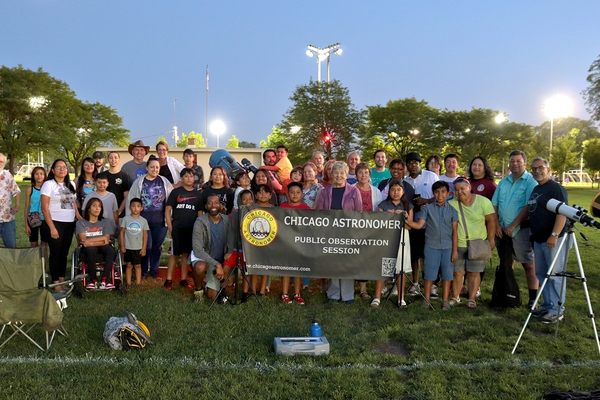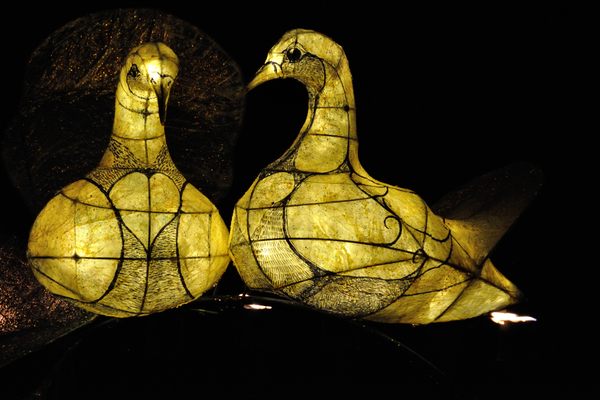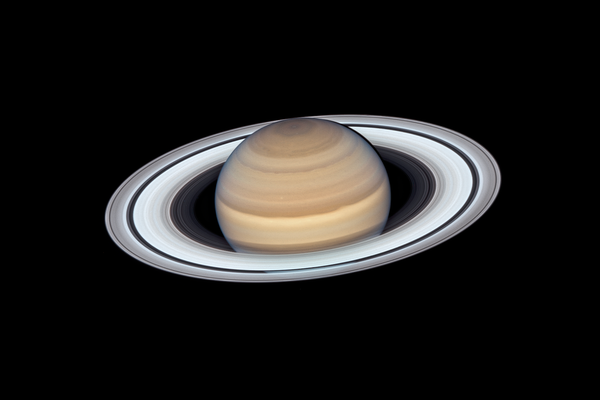A Holiday Gift Guide for Winter Stargazing and More
From telescopes to fun and functional hats, we’ve got ideas for every astro-enthusiast in your life this giving season.
Atlas Obscura’s Wondersky columnist Rebecca Boyle is an award-winning science journalist and author of the upcoming Our Moon: How Earth’s Celestial Companion Transformed the Planet, Guided Evolution, and Made Us Who We Are (January 2024, Random House). She regularly shares the stories and secrets of our wondrous night sky.
The night sky is something we all share, for free, forever. You really don’t need any tools to behold the beauty of the stars and other planets. Equipped with your five senses, just go outdoors at night and explore the universe around you. That said, it sure is nice to have the right pair of slippers, or an excellent hot chocolate vessel, or a good, simple telescope.
From basic equipment to luxury items and random tchotchkes, we chose the items on this list for the stargazer in your life. Maybe that’s you, or a loved one—or maybe it’s someone you’ve been trying to coax out into the cold night to join you.
Whatever traditions you follow this Northern Hemisphere winter season, whatever you use to brighten its long nights, may the Moon and stars keep you company.
Books and other page-turners
Every stargazer should have a good atlas or at least a basic guide. I often use a planisphere and an app on my phone, but highly recommend the book Turn Left At Orion, by Vatican astronomer Guy Consolmagno and coauthor Dan M. Davis. Get the spiral-bound edition and you won’t have to worry about losing your page. For a gift that keeps giving all year, consider a subscription to either Sky & Telescope magazine or Astronomy, both leading publications for amateur and professional astronomers alike.

Red light
It takes a good 20 minutes in the darkness before your eyes fully acclimate to the night sky. You don’t want to wreck that by using a white light to read. If my recommended taillight-tape-covered Mini Maglite is no longer cutting it, splurge on a red-light headlamp, or a regular headlamp with a dedicated red light setting. I like the Petzl ACTIK CORE Headlamp for its ease of use; you can lock it onto its red-light setting and turn it on and off with the push of a button. Another option I recommend: the Nitecore NU31 Headlamp, which also has a red-light setting.
Fingerless gloves
Sometimes you have to turn the wheel of your planisphere or a page of your sky atlas, swipe the app on your phone, or fiddle with the focus on your telescope or binoculars. It’s annoying to constantly remove gloves and then put them back on. A set of fingerless gloves, ideally with a convertible flap that covers your fingers, is an easy solution. I live in Colorado, where we don’t mess around with cold temperatures at night, and recommend Patagonia’s unisex Better Sweater Gloves.
Delicious ways to stay warm
Hot chocolate, a hot toddy, tea, or anything warm can make a night in the cold air feel cozy. While many brands offer nicely insulated stainless steel bottles, I like Yeti’s quality and customizable designs. I have and recommend the 18-ounce Hot Shot (in cosmic lilac, of course). And if you really want to lean into cosmic themes, personalize it with your favorite astrological sign, no horoscope needed. The zodiac signs are all based on constellations known to the ancient Babylonians, so if anyone asks “Are you a Taurus?” you can say, “No, I just really like the legend of the Bull of Heaven,” and call it a night.

A stargazing blanket
Stargazing often means sitting still or standing at a telescope for long periods, so every stargazer should have a good blanket to tote around. If you’re looking for convenience, I recommend this packable blanket by Pendleton; its designs look sharp at a campsite or in the back of your car, and the carrying strap makes it easy to haul hands-free. For a night sky-themed choice, this constellation-themed blanket glows in the dark, but not in a way that will interfere with your dark-adapted vision.
Don’t forget the feet!
Nobody likes cold feet, especially when you’re out and about at night. Merrell’s Hut Moc 2 is a cross between a slipper and a walking shoe, with a sturdy, grippy sole and a quilted top layer for warmth. You can slip it on like a shoe, or push the back flap down with your heel and wear it as a clog. Stay on-theme by choosing the color option “moonbeam.”
More than a hat
You’ll likely need a warm hat as well—why not one that’s also a cheat sheet for knowing where the Moon is? When you put on the Moon Phase Fleece Beanie with its embroidered new moon symbol facing forward, you can use the hat, along with the sun’s position and the current phase of the Moon, to learn the location of our lunar friend at that moment.

Not every night is right for stargazing, so bring the joy of the cosmos inside, or wear it every day with these additional astro-themed gift ideas:
By the Light of the Moon
A moon lamp is just what it sounds like, and it’s a surprisingly fun thing to have around. Secure on its own little wooden stand, the detailed globe of our Moon displays bright white or warm golden light and can serve as a lamp or a nightlight. The newest version comes with a remote control that lets you change the color and brightness, and even set a timer to turn it off automatically. I have two of these in my house.
A Handy Moon Almanac
Every year, I order Moon Over Me’s set of three magnetic and three paper cards that show the phases of the Moon throughout the year. I keep one on my desk and another on my fridge, and use one as a bookmark in my daily planner; any extras make great small gifts. The mini-almanacs are helpful for planning a stargazing trip: it’s ideal to look for deep-sky objects during the early or late part of the lunar cycle, when the sky is darkest. There are dozens of apps that do this, too, but I like having a paper calendar around.
Wear Your Passion
While Etsy is replete with custom-made astronomy items, I am partial to anything made by Emily Lakdawalla, a science writer, author, former editor at the Planetary Society, and generally excellent craftsperson. Emily’s Space Craft specializes in creative concepts that she brings to life with jewelry. My personal favorites are necklaces inspired by the solar life cycle and the Hertzsprung-Russell diagram, which charts every star’s life cycle. They are lovely beaded necklaces, calling to mind something you might find in a Murano glass gift shop, but they hold deeper meanings that astronomy enthusiasts will appreciate.

If your stargazer is not partial to space jewelry, don’t fret—you can find a bevy of neckties, hats, lapel pins, socks, and other accessories in almost any category on Startorialist, founded by astrophysicist Emily Rice and astronomer Summer Ash.
Safely Sungaze
Stargazers are getting hyped for the upcoming total solar eclipse in April 2024. Shop now for paper eclipse glasses or, even better, durable plastic ones that will last well beyond the big day. Bonus: The glasses can be used to view the sun anytime, not just during a partial eclipse; safely sungazing is something I recommend, especially during the often gloomy winter months. Safety is the key word here: Avoid potentially shoddy products by purchasing your peeper protectors only from an optics dealer, such as B&H Photo and Video.
Scope This Out
Telescopes are popular gifts for budding stargazers, but choosing the right one for a particular person requires a little research. I recommend consulting a few online buying guides, such as those available from Sky & Telescope and B&H.
The most important thing to consider when buying a telescope is its aperture. This is sometimes also called its objective. This refers to the diameter of the light-gathering mirror, and determines how far away—and how faint the objects—you’ll be able to see. You want to start with at least a 70 millimeter aperture, but the larger, the better (and the more expensive).
Generally speaking, you’ll also have to decide between three telescope types: refracting, reflecting (also called Newtonian), or compound.

A refracting telescope is the iconic, long-barrel telescope most people would recognize. It works by gathering light through its front lens, which bounces off a mirror in the back, sending the light upward into your eyepiece. Benefits include ruggedness and ease of use for taking photos; drawbacks include their size and high cost.
A reflecting or Newtonian telescope has a thicker, shorter barrel and doubles up on the mirrors. Again, a main front lens lets in light, which bounces off a mirror in the back that is the same size as the opening lens. This mirror reflects light toward another, smaller mirror, which sends light to the eyepiece.
Dobsonian telescopes, a popular type of reflector, sit on the ground rather than a tripod, and can give you a lot of aperture. Benefits include relatively lower cost; drawbacks include their more delicate nature.
Compound telescopes, the third general type, work like reflecting telescopes to bounce light around, sometimes many times. Benefits include a lot of aperture at lower cost; drawbacks include the likelihood of needing to make more frequent adjustments to keep objects crisp and clear.
However you chose to experience the night, wishing you clear skies and good seeing this winter season.
Is there something you’d like to know about our brilliant night sky? Share your stargazing questions with us and you may see them answered in a future Wondersky column!










Follow us on Twitter to get the latest on the world's hidden wonders.
Like us on Facebook to get the latest on the world's hidden wonders.
Follow us on Twitter Like us on Facebook